Easy One-Pot Bibimbap with Beef & Gochujang: Korean Rice Bowl Recipe
"Make this easy one-pot bibimbap with beef and gochujang sauce - a comforting Korean rice bowl with veggies, soft egg, and spicy-savory flavor!"
(5) default ratingBy Food and Spot, May 16, 2025

ingredients
- 1 zucchini
- 1 carrot
- 3 shiitake mushrooms
- ½ bunch of spinach
- 100g minced beef
- 3 tbsp gochujang
- 1 tbsp minced garlic
- 2 tbsp soy sauce
- 1 tbsp sugar
- 1 egg, soft-boiled or half-boiled
- 1 tbsp sesame oil per serving
- Optional: sesame seeds
Easy One-Pot Bibimbap Recipe with Beef Gochujang Sauce: A Comforting Korean Rice Bowl
Looking for a delicious Korean food idea that’s easy, satisfying, and perfect for lunch or dinner? This bibimbap recipe is a warm hug in a bowl - filled with vibrant vegetables, savory beef gochujang sauce, and topped with a soft, half-boiled egg. It’s not only beautiful to look at but also incredibly nourishing and customizable based on what you have in the fridge.
In this version, I simplify the traditional stir-fry method by cooking the vegetables all together in one pot. It saves time and still delivers the classic, layered flavors of this beloved Korean dish.
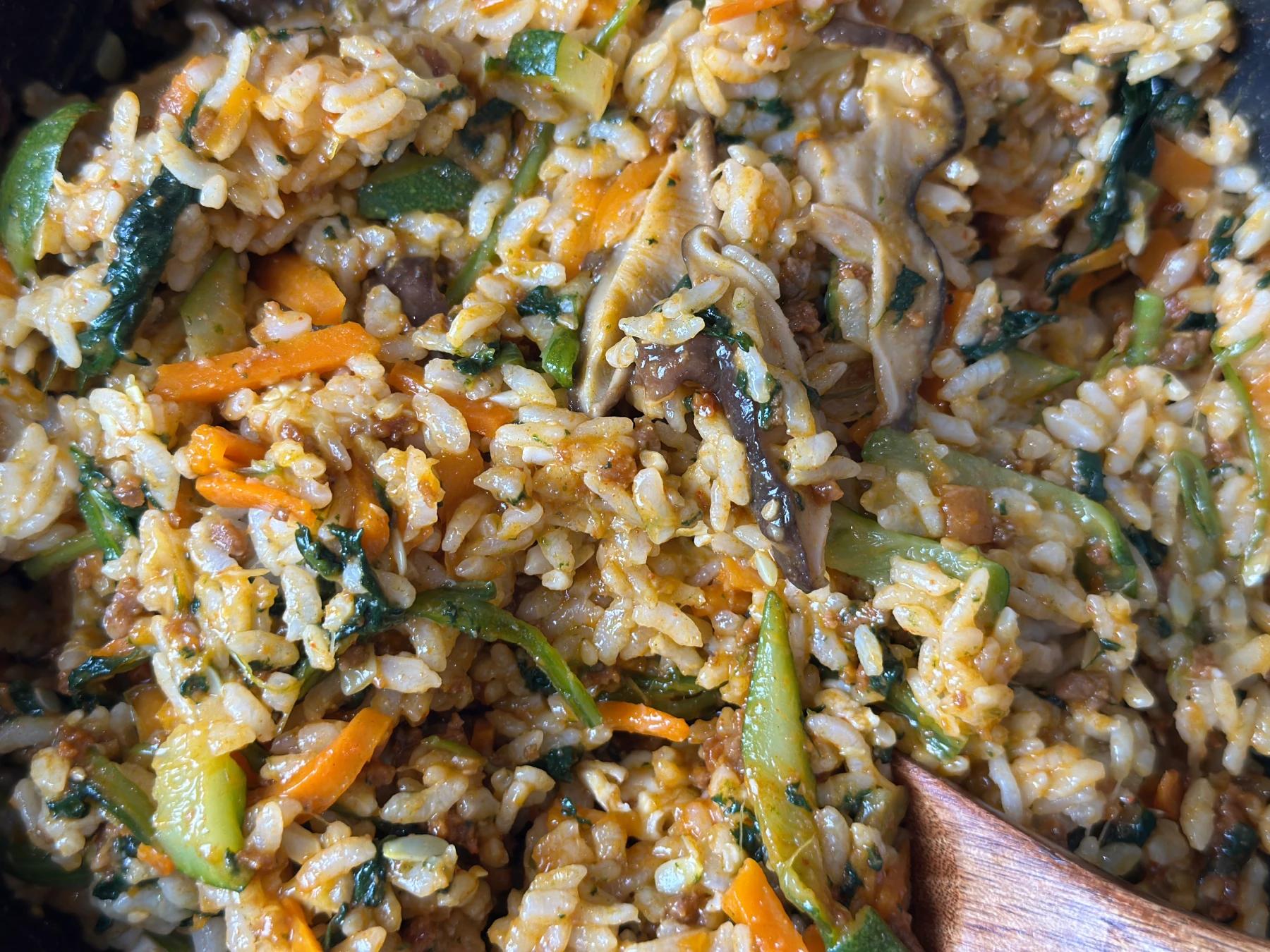
What Is Bibimbap? - Traditional Korean Mixed Rice Bowl Explained
Bibimbap translates to “mixed rice” in Korean. It’s a colorful bowl of warm white rice topped with an assortment of sautéed or blanched vegetables (namul), meat (often beef), a fried or soft egg, and gochujang (Korean red pepper paste). Before eating, everything is stirred together so each bite is bursting with flavor.
It’s one of the most iconic and versatile Korean dishes, traditionally served in a hot stone bowl (dolsot) that crisps up the bottom layer of rice. But it can also be made easily at home in a regular bowl, like I did here.
This homemade bibimbap is my go-to when I want something quick, comforting, and packed with nutrition.
Why This One-Pot Bibimbap Recipe Works
- Easy One-Pot Cooking - No need to stir-fry each vegetable separately.
- Perfect for Meal Prep - Make the toppings ahead and assemble when needed.
- Customizable - Use any vegetables or protein you like.
- Balanced and Nutritious - Full of fiber, protein, and healthy fats.
- Great Dinner or Lunch Idea - Quick enough for weeknights and satisfying for lunch.
- Vegan Option - Just mix rice and Veggie with soy sauce or any vegan sauce you want!
Ingredients for Beef Gochujang Bibimbap
Fresh Vegetables for Color and Texture
- 1 zucchini, julienned
- 1 carrot, julienned
- 3 shiitake mushrooms, thinly sliced
- ½ bunch of spinach, cleaned and trimmed
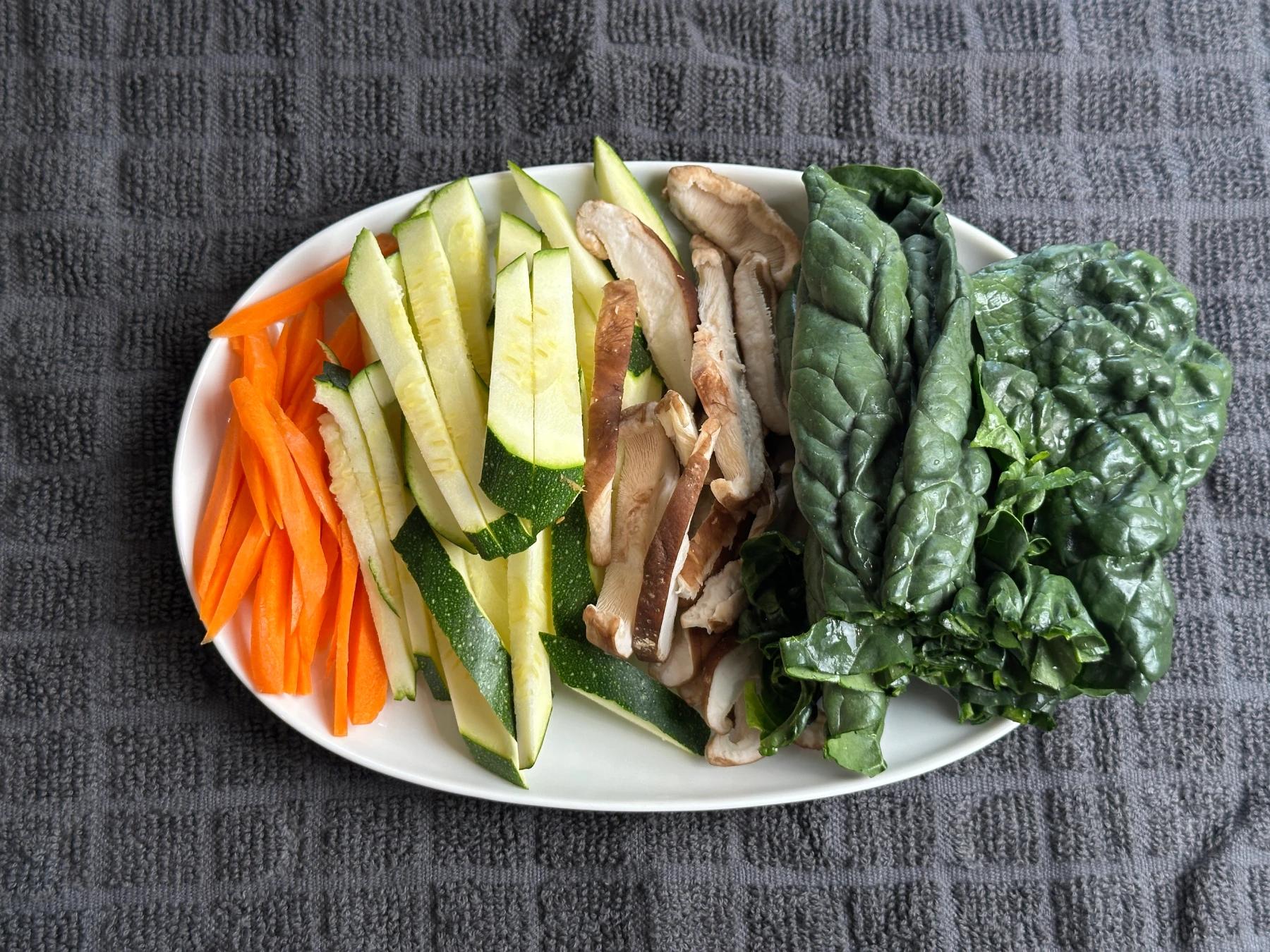
Steamed Short-Grain Rice - The Heart of Bibimbap
- Steamed short-grain white rice (about 1 cup per serving)
Beef Gochujang Sauce - The Flavor Powerhouse
- 100g minced beef
- 3 tbsp gochujang (Korean red pepper paste)
- 1 tbsp minced garlic
- 2 tbsp soy sauce
- 1 tbsp sugar
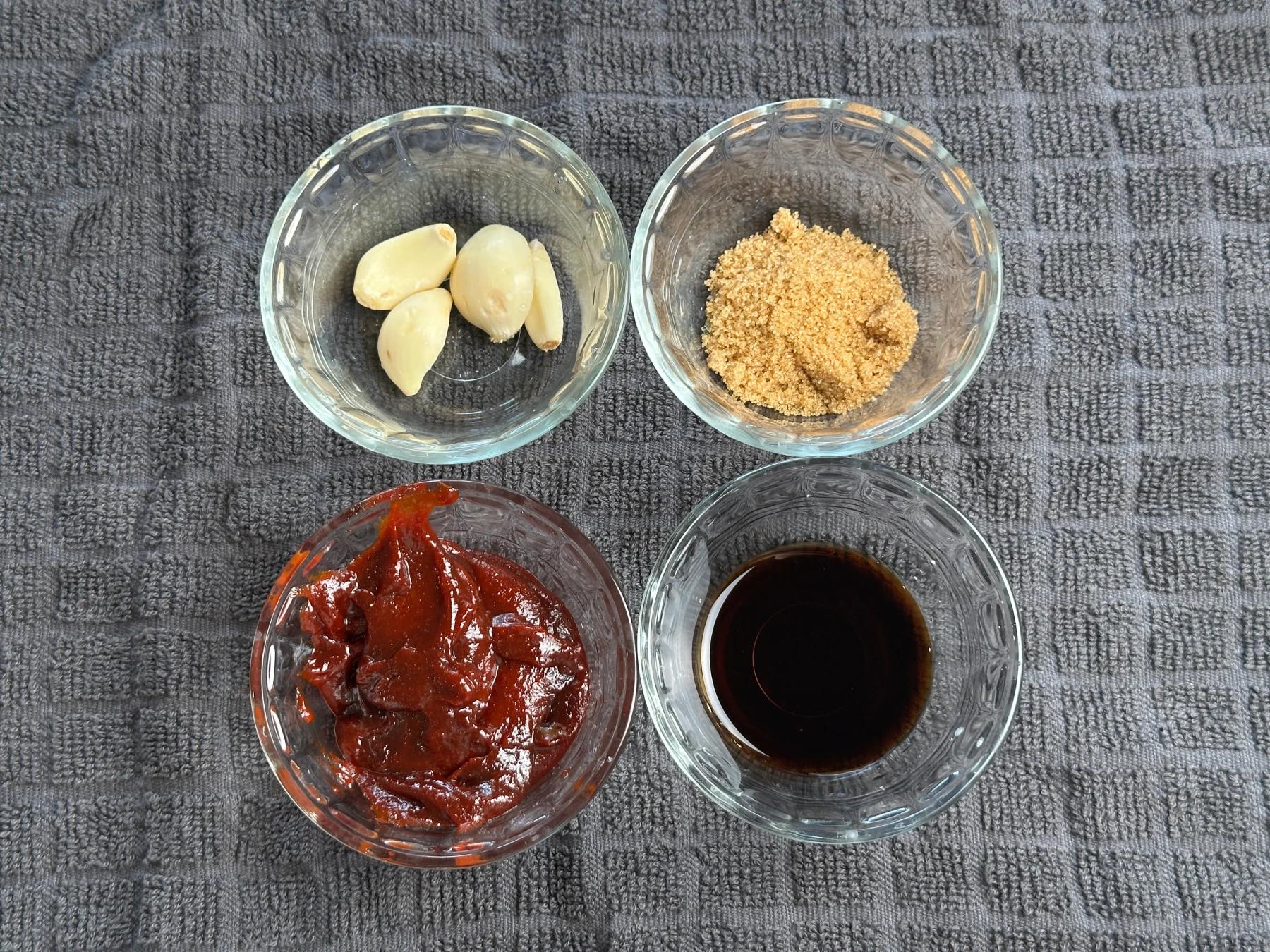
Egg for Creamy Topping
- 1 egg, soft-boiled or half-boiled or sunny sideup
- 1 tbsp sesame oil per serving
- Optional: sesame seeds
Step-by-Step: How to Make One-Pot Bibimbap at Home
1. Cook All Vegetables Together in One Pot
In a medium pot, combine:
- The julienned zucchini
- Carrot
- Sliced shiitake mushrooms
- Spinach
Add about 100ml of water and a small pinch of salt. Cover the pot and simmer over medium heat for around 6 minutes, or until all the vegetables are tender but still vibrant.
This method softens the veggies and lightly steams them together, letting their flavors blend beautifully while keeping cleanup minimal. It’s perfect for busy days when you want a wholesome, veggie-packed meal without juggling multiple pans.
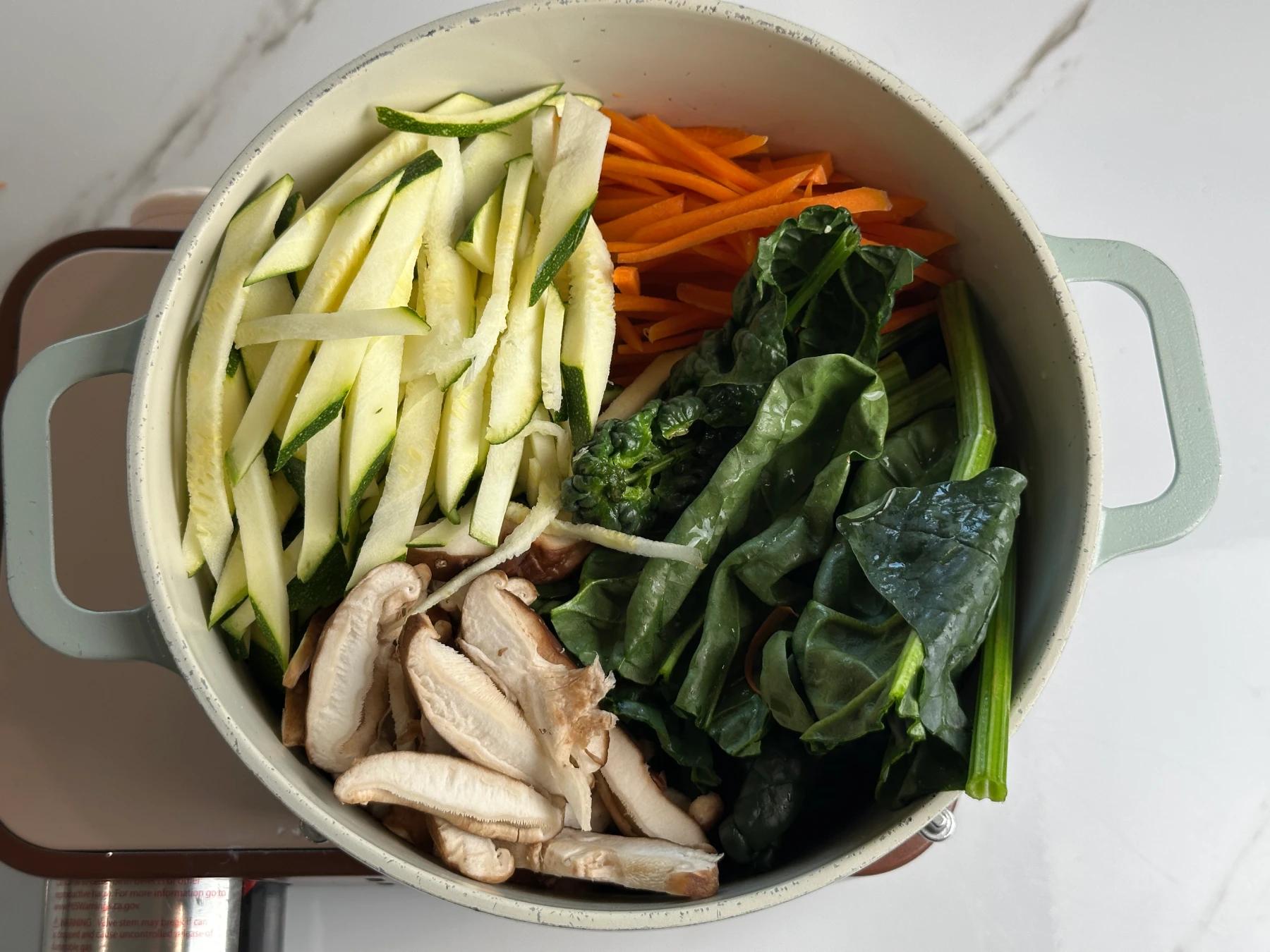
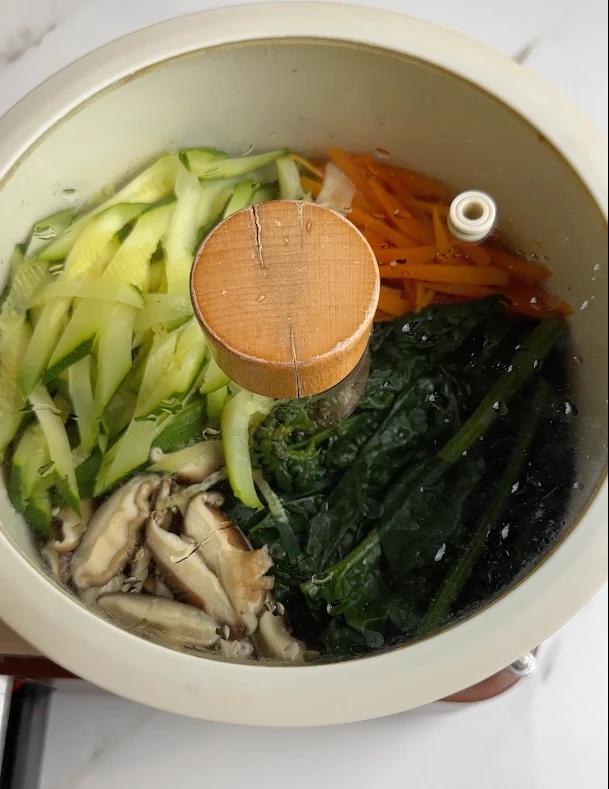
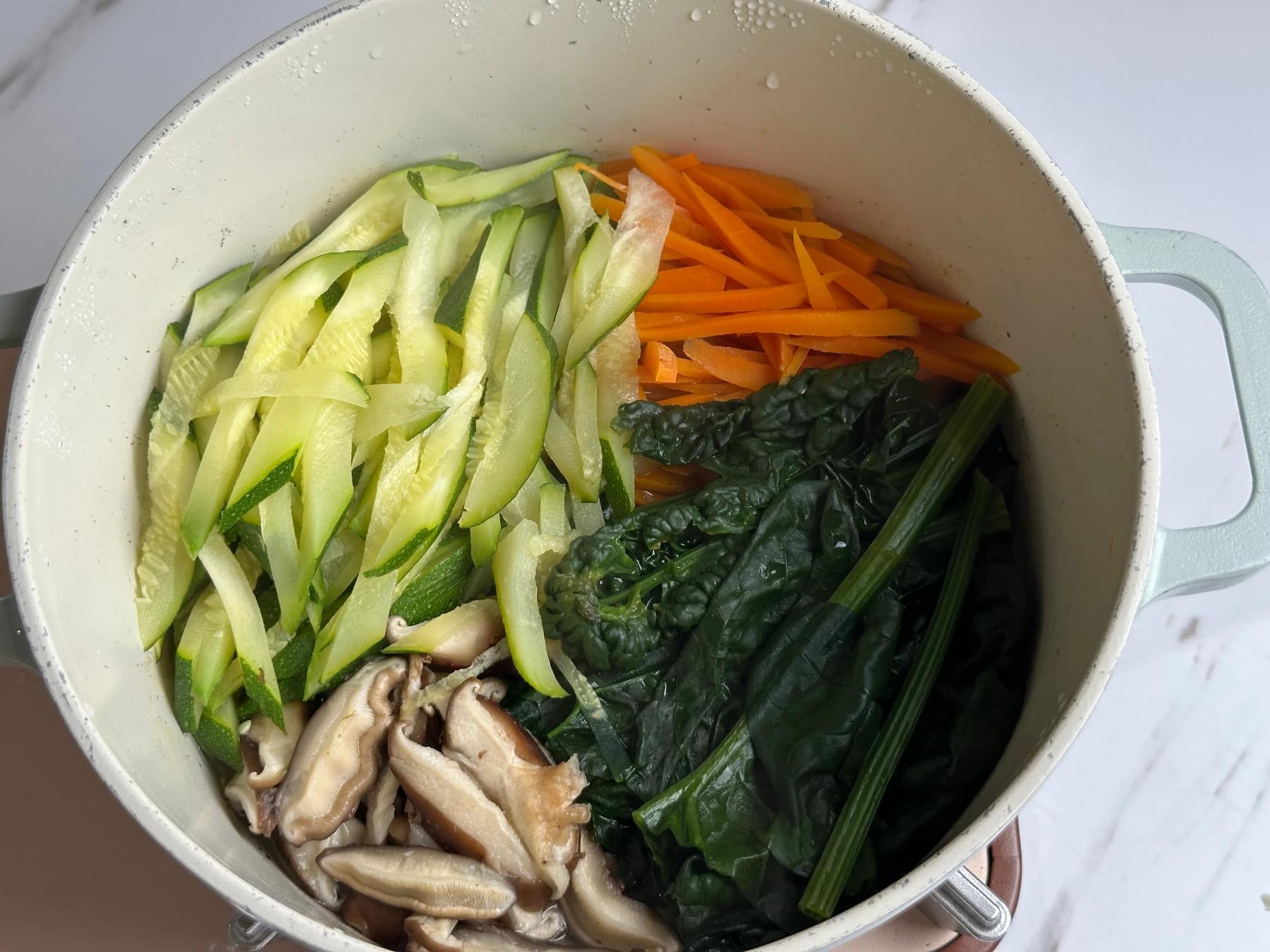
2. Make Savory Beef Gochujang Sauce
In a small pan, cook the 100g of minced beef over medium heat until just browned.
Then, add:
- 3 tbsp gochujang
- 1 tbsp minced garlic
- 2 tbsp soy sauce
- 1 tbsp sugar
Mix everything well and let it simmer for 2-3 minutes, stirring occasionally, until the sauce thickens slightly and the flavors come together. This sauce is savory, slightly sweet, spicy, and deeply umami, it’s what really ties the dish together.
You can make this sauce ahead of time and store it in the fridge for up to 3 days.
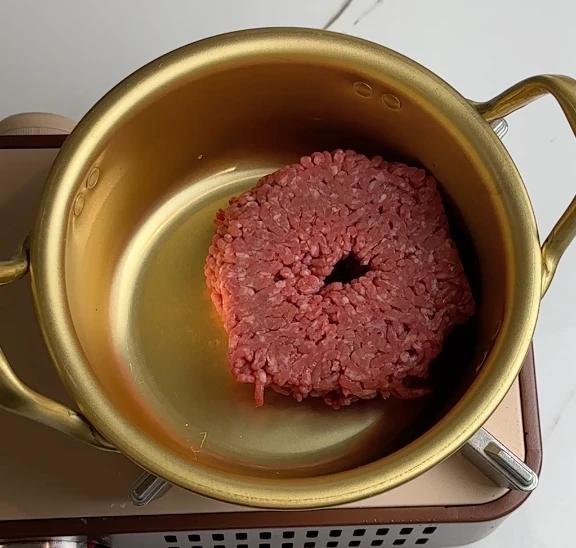
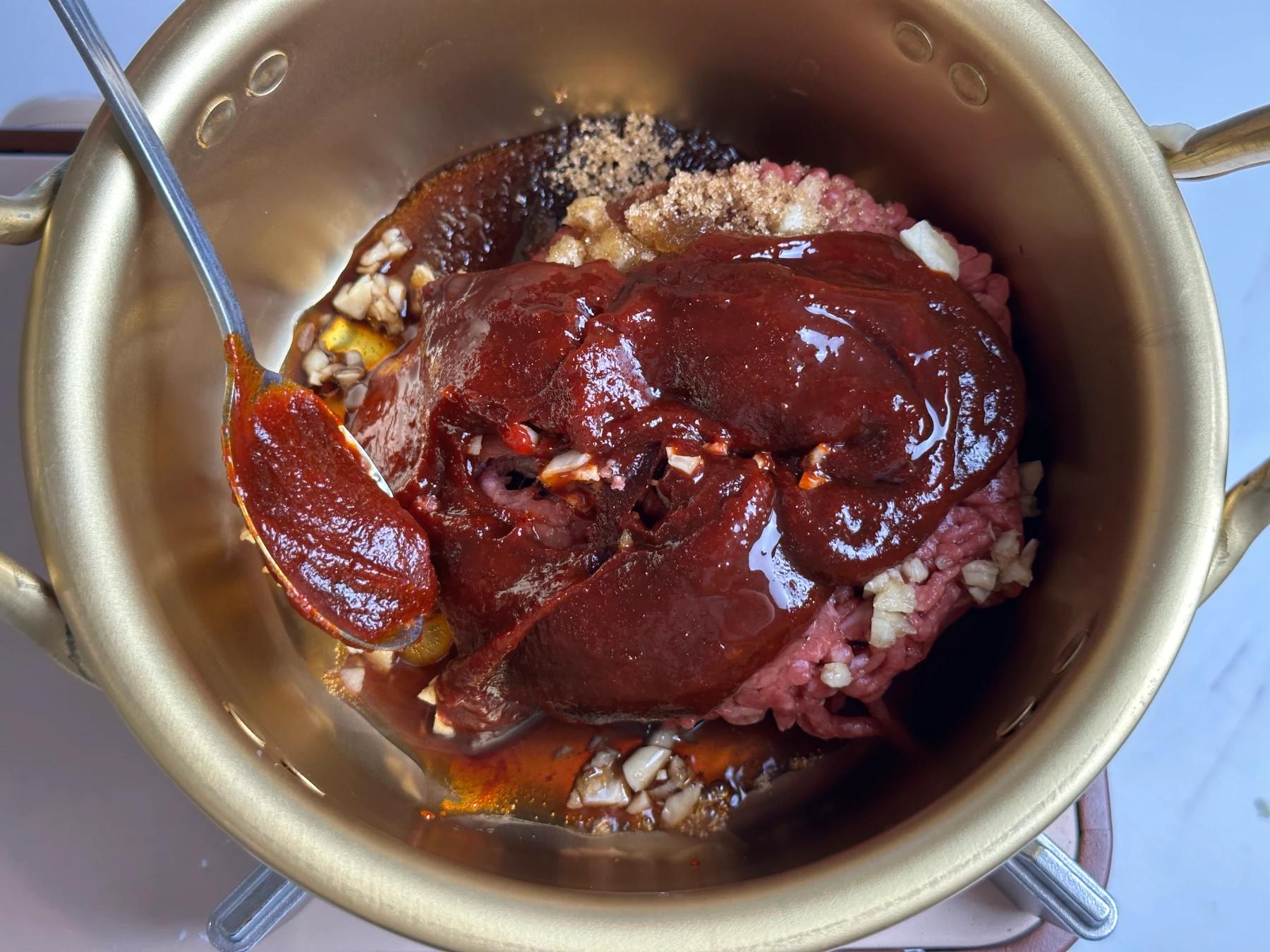
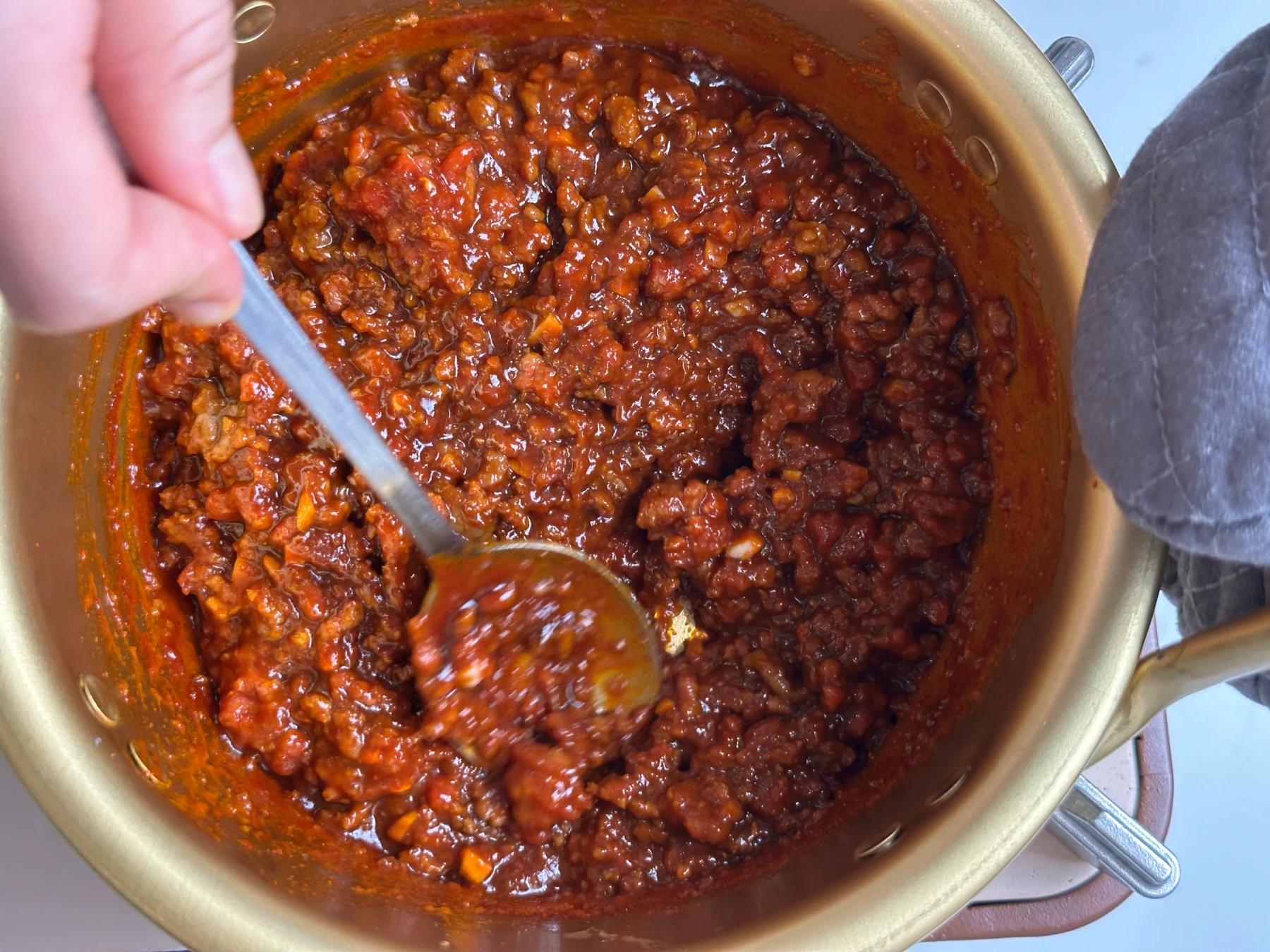
3. Sunny Side Up Egg for a Creamy Finish
Bring a small pan and cook your egg sunny side up. Boiled egg will works too!
4. Assemble Your Homemade Bibimbap Bowl
In a bowl, start with a generous scoop of steamed rice.
Top with:
- The cooked vegetables (arranged separately or mixed)
- A spoonful (or two) of the beef gochujang sauce
- The soft-boiled egg
- A drizzle of toasted sesame oil
- Optional toppings like sesame seeds or sliced scallions
Mix everything together before eating, and enjoy the burst of textures and flavors in every bite.
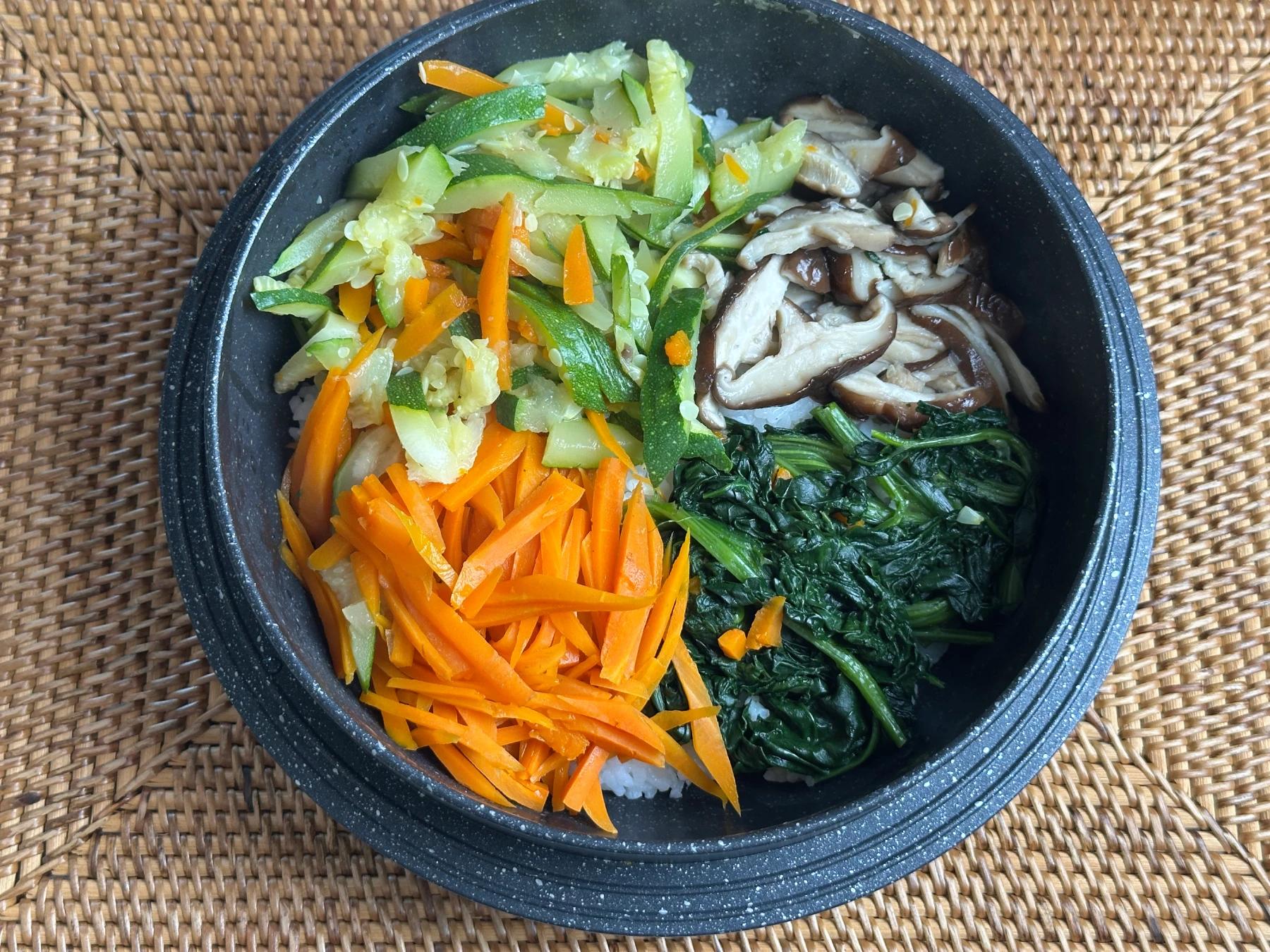
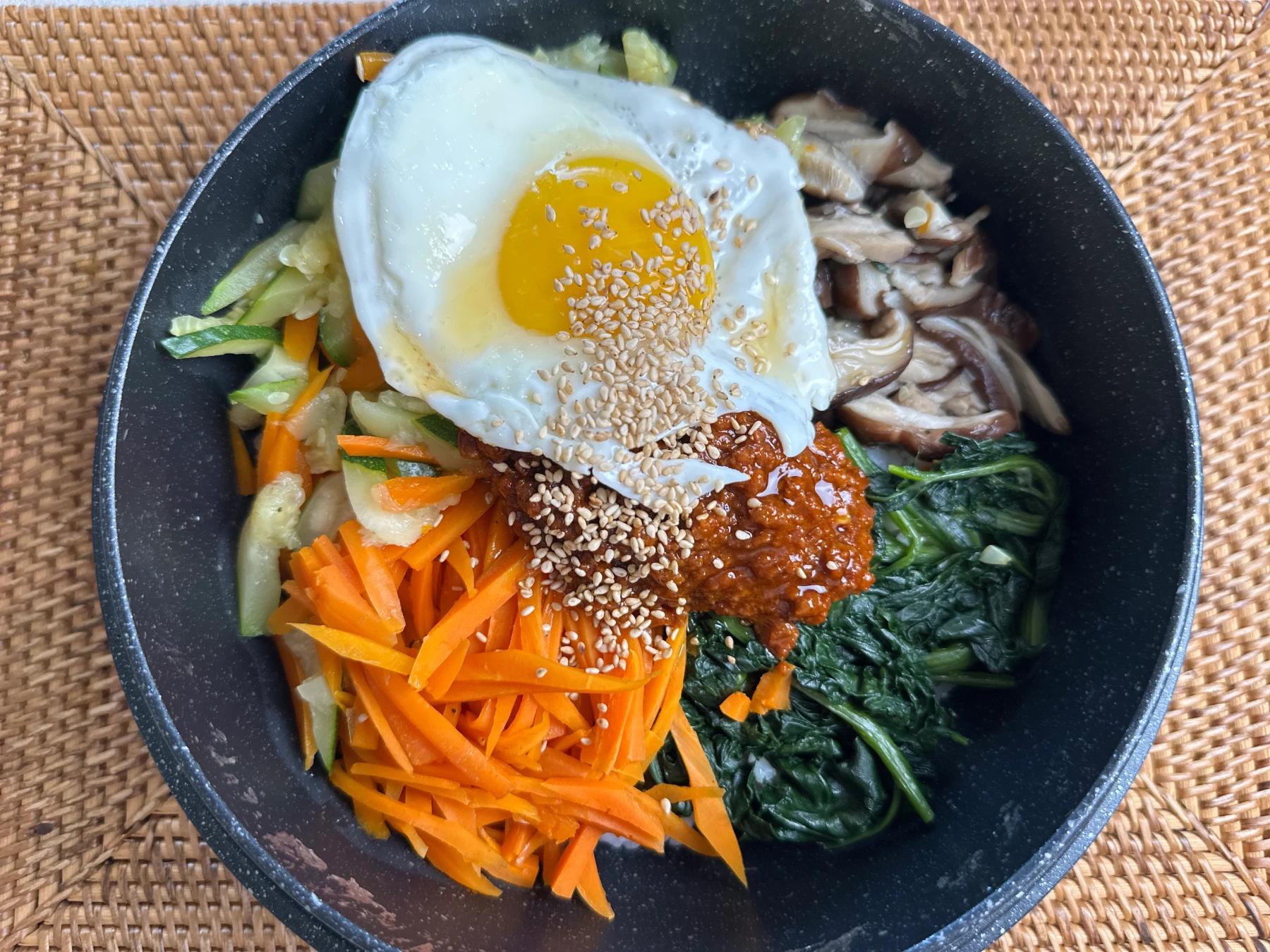
How to Customize Bibimbap to Your Taste
- Vegan Bibimbap: Skip the beef and make a gochujang sauce with soy sauce, garlic, sugar, and a dash of sesame oil. Or try tofu!
- Add More Veggies: You can also add bean sprouts, cucumbers, or bell peppers.
- Spicy Kick: If you like it extra spicy, add a bit of Korean chili flakes (gochugaru) or more gochujang.
- Crispy Rice: For a dolsot-style bibimbap, press your cooked rice into a hot, oiled pan and let it crisp up before adding toppings.
This recipe balances flavor, nutrition, and convenience. Traditional bibimbap can take time due to the separate preparation of each vegetable. By lightly steaming the vegetables together, we retain their bright colors and nutritional value while making the process more efficient.
The beef gochujang sauce adds depth and richness, especially when paired with the mild vegetables and soft rice. The egg finishes it with a creamy, luxurious texture. Together, they make the perfect Korean comfort food.
A Brief Note on Bibimbap’s History
Bibimbap has roots in Korean royal court cuisine, but it’s also deeply connected to everyday home cooking. It’s often eaten on Lunar New Year’s Eve to use up leftover vegetables, a tradition rooted in reducing food waste and starting the new year with a clean slate.
Today, bibimbap is one of Korea’s most internationally recognized dishes - celebrated for its color, variety, and balance. It’s endlessly adaptable and can be both humble and refined.
What to Serve with Bibimbap: Korean Side Dish Ideas
Serve bibimbap with:
- A small bowl of miso soup or doenjang jjigae (fermented soybean paste stew)
- A side of kimchi for added zing
- Pickled radish or cucumber for a crisp contrast
It’s a filling, balanced meal on its own, but you can round it out with small side dishes (banchan) for the full Korean dining experience.
Final Thoughts: Why This Simple Bibimbap Recipe Is Worth Trying
This easy bibimbap recipe proves that you don’t need a long list of ingredients or a complicated process to enjoy a satisfying Korean rice bowl at home. With just a few fresh veggies, flavorful beef gochujang sauce, and a soft egg, you’ve got a deeply comforting and healthy dish perfect for any night of the week.
If you’re looking for a flavorful dinner idea that’s good for you and deeply satisfying, give this bibimbap a try. You can make it ahead, customize it to your taste, and enjoy the harmony of Korean flavors in one bowl.
Leave a comment
Comments
No comments yet.